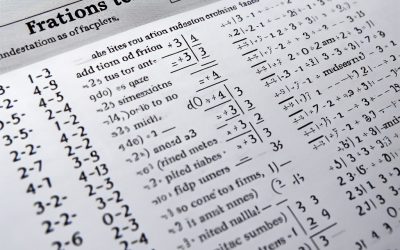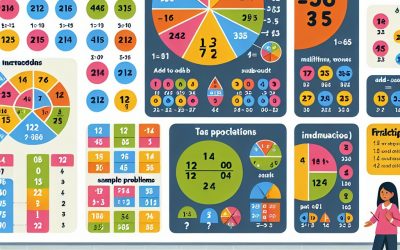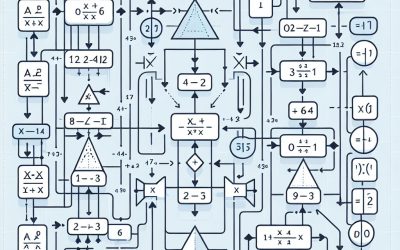➕ Introduction to Mathematics
The Language of Patterns, Logic, and Problem-Solving
Mathematics is the science of numbers, shapes, patterns, and relationships. It provides a universal language to describe the world around us—whether we’re counting, measuring, predicting, or solving complex problems. More than just calculations, maths is a way of thinking: logical, precise, and creative.
At its core, mathematics explores questions like:
-
How do we measure and compare things?
-
What happens when we follow certain rules or operations?
-
How can we predict outcomes or analyse patterns?
-
What structures exist beneath the surface of reality?
Maths is used in every area of life—from calculating a grocery bill to designing bridges, forecasting the weather, or sending spacecraft to Mars. It’s essential in science, engineering, technology, economics, architecture, and even music and art.
Divided into fields such as arithmetic, algebra, geometry, statistics, and calculus, mathematics grows more powerful as we explore deeper concepts. And it’s not just about finding the right answer—it’s about understanding why it’s right, and discovering new ways to think.
Studying maths sharpens our ability to reason, solve problems, and recognise the hidden patterns that shape our world.
Unlocking the Power of Equations: How Math Can Help Solve Real-World Problems
Equations are powerful tools that have the ability to solve complex problems and provide insights into the world around us. From the simplest calculations to the most intricate scientific research, math plays a crucial role in everyday life. Whether it’s calculating the cost of groceries, designing a bridge, or understanding the behavior of particles in a chemical reaction, math is at the heart of problem solving. Mathematics is not just a subject taught in schools; it is a fundamental part of our daily lives. It helps us make sense of the world and provides us with the tools to navigate through it. From managing personal finances to making informed decisions about health and well-being, math is an essential skill that empowers individuals to make better choices. Key Takeaways Equations are a powerful tool for solving real-world problems. Math plays a crucial role in tackling complex issues across various fields. Equations are essential in scientific research and development. Math is applied to engineering, technology, economic, business, environmental, social, political, healthcare, and medical challenges. The future of math is promising in solving global issues for a better world. Understanding the Role of Math in Tackling Complex Issues Mathematics is particularly important when it comes to tackling complex issues that require analytical thinking and problem-solving skills. For example, climate change is a complex issue that requires mathematical models to understand and predict its impact on the environment. By using equations to model the behavior of greenhouse gases and their effect on temperature, scientists can make informed decisions about mitigating climate change. Another example is in the field of economics, where math is...
Unlocking the Power of Algebra: How to Solve Complex Equations with Ease
Algebra is a branch of mathematics that deals with symbols and the rules for manipulating those symbols. It is a fundamental part of mathematics and is used in various fields such as science, engineering, economics, and computer science. Algebra allows us to solve problems and make predictions by using equations and expressions. In this post, we will cover various topics in algebra, including simplifying algebraic expressions, solving linear equations, factoring quadratic equations, graphing linear equations, solving systems of equations, simplifying and solving rational expressions, understanding exponential and logarithmic functions, working with complex numbers, and using advanced algebraic techniques such as polynomial division and synthetic division. Key Takeaways Algebra is a branch of mathematics that deals with symbols and the rules for manipulating those symbols. Simplifying algebraic expressions involves combining like terms, using the distributive property, and factoring. Solving linear equations requires isolating the variable by performing the same operation on both sides of the equation. Quadratic equations can be solved by factoring or completing the square. Graphing linear equations involves finding the slope and y-intercept of the equation’s line. Simplifying Algebraic Expressions: Tips and Tricks Algebraic expressions are mathematical phrases that contain variables, constants, and operations such as addition, subtraction, multiplication, and division. They are used to represent relationships between quantities and can be simplified by combining like terms and using the distributive property. Like terms are terms that have the same variables raised to the same powers. To simplify an expression with like terms, you can combine the coefficients of those terms. The distributive property states that for any real numbers a, b, and c, a(b + c)...
Subtracting Fractions with Different Denominators Test
Your Subtracting Fractions with Different Denominators Test may take a minute to load. If you have to navigate away from this page for any reason, don’t worry, you will have the option to resume your test from the point you left upon your return. The test may have multiple choice, multiple answer or true/false questions and is timed but has no time limit. It should be considered an aid to study for exams or merely a test of your knowledge base giving you indication of areas you may need further study in. Once you have completed your test you will be able to review your results. This will give you some indication of the area you need further study or which areas you are proficient. We recommend you take the Subtracting Fractions with Different Denominators Test before reading the subject matter. If you score 80% or more than you have the option of skipping the section but if you score less than 80% we recommend you read the material associated. Then try the test again until you are able to gain a passing result of 80% correct. Error: Embedded data could not be displayed. Why Use the Subtracting Fractions with Different Denominators Test? As previously stated tests give the user indication of their strengths and weaknesses. This allows them to spend less time studying things they are proficient in and spend more time improving their knowledge where they may have gaps. Tests are also a great tool for revision because they require the user to recall information they...
Subtracting Fractions with the Same Denominator Test
If you have to navigate away from this page for any reason, don’t worry, you will have the option to resume your test from the point you left upon your return. The test may have multiple choice, multiple answer or true/false questions and is timed but has no time limit. It should be considered an aid to study for exams or merely a test of your knowledge base giving you indication of areas you may need further study in. Once you have completed your test you will be able to review your results. This will give you some indication of the area you need further study or which areas you are proficient. We recommend you take the Subtracting Fractions with the Same Denominator Test before reading the subject matter. If you score 80% or more than you have the option of skipping the section but if you score less than 80% we recommend you read the material associated. Then try the test again until you are able to gain a passing result of 80% correct. Error: Embedded data could not be displayed. Why Use the Subtracting Fractions with the Same Denominator Test? As previously stated tests give the user indication of their strengths and weaknesses. This allows them to spend less time studying things they are proficient in and spend more time improving their knowledge where they may have gaps. Tests are also a great tool for revision because they require the user to recall information they may have previously learnt, be it recently or some time ago. This recall of information improves its retention in your mind by...
Adding Fractions with Different Denominators Test
Your Adding Fractions with Different Denominators Test may take a minute to load. If you have to navigate away from this page for any reason, don’t worry, you will have the option to resume your test from the point you left upon your return. The test may have multiple choice, multiple answer or true/false questions and is timed but has no time limit. It should be considered an aid to study for exams or merely a test of your knowledge base giving you indication of areas you may need further study in. Once you have completed your test you will be able to review your results. This will give you some indication of the area you need further study or which areas you are proficient. We recommend you take the Adding Fractions with Different Denominators Test before reading the subject matter. If you score 80% or more than you have the option of skipping the section but if you score less than 80% we recommend you read the material associated. Then try the test again until you are able to gain a passing result of 80% correct. Error: Embedded data could not be displayed. Why Use the Adding Fractions with Different Denominators Test? As previously stated tests give the user indication of their strengths and weaknesses. This allows them to spend less time studying things they are proficient in and spend more time improving their knowledge where they may have gaps. Tests are also a great tool for revision because they require the user to recall information they...
Adding Fractions with the Same Denominator Test
Your Adding Fractions with the Same Denominator Test may take a minute to load. If you have to navigate away from this page for any reason, don’t worry, you will have the option to resume your test from the point you left upon your return. The test may have multiple choice, multiple answer or true/false questions and is timed but has no time limit. It should be considered an aid to study for exams or merely a test of your knowledge base giving you indication of areas you may need further study in. Once you have completed your test you will be able to review your results. This will give you some indication of the area you need further study or which areas you are proficient. We recommend you take the Adding Fractions with the Same Denominator Test before reading the subject matter. If you score 80% or more than you have the option of skipping the section but if you score less than 80% we recommend you read the material associated. Then try the test again until you are able to gain a passing result of 80% correct. Error: Embedded data could not be displayed. Why Use the Adding Fractions with the Same Denominator Test? As previously stated tests give the user indication of their strengths and weaknesses. This allows them to spend less time studying things they are proficient in and spend more time improving their knowledge where they may have gaps. Tests are also a great tool for revision because they require the user to...
Improper Fractions Test
Your Improper Fractions Test may take a minute to load. If you have to navigate away from this page for any reason, don’t worry, you will have the option to resume your test from the point you left upon your return. The test may have multiple choice, multiple answer or true/false questions and is timed but has no time limit. It should be considered an aid to study for exams or merely a test of your knowledge base giving you indication of areas you may need further study in. Once you have completed your test you will be able to review your results. This will give you some indication of the area you need further study or which areas you are proficient. We recommend you take the Improper Fractions Test before reading the subject matter. If you score 80% or more than you have the option of skipping the section but if you score less than 80% we recommend you read the material associated. Then try the test again until you are able to gain a passing result of 80% correct. Error: Embedded data could not be displayed. Why Use the Improper Fractions Test? As previously stated tests give the user indication of their strengths and weaknesses. This allows them to spend less time studying things they are proficient in and spend more time improving their knowledge where they may have gaps. Tests are also a great tool for revision because they require the user to recall information they may have previously learnt, be it recently or some...
Simplifying or Reducing Fractions Test
Your Simplifying Fractions Test may take a minute to load. If you have to navigate away from this page for any reason, don’t worry, you will have the option to resume your test from the point you left upon your return. The test may have multiple choice, multiple answer or true/false questions and is timed but has no time limit. It should be considered an aid to study for exams or merely a test of your knowledge base giving you indication of areas you may need further study in. Once you have completed your test you will be able to review your results. This will give you some indication of the area you need further study or which areas you are proficient. We recommend you take the Simplifying Fractions Test before reading the subject matter. If you score 80% or more than you have the option of skipping the section but if you score less than 80% we recommend you read the material associated. Then try the test again until you are able to gain a passing result of 80% correct. Error: Embedded data could not be displayed. Why Use the Simplifying Fractions Test? As previously stated tests give the user indication of their strengths and weaknesses. This allows them to spend less time studying things they are proficient in and spend more time improving their knowledge where they may have gaps. Tests are also a great tool for revision because they require the user to recall information they may have previously learnt, be it recently or some...
Equivalent Fractions Test
Your Equivalent Fractions Test may take a minute to load. If you have to navigate away from this page for any reason, don’t worry, you will have the option to resume your test from the point you left upon your return. The test may have multiple choice, multiple answer or true/false questions and is timed but has no time limit. It should be considered an aid to study for exams or merely a test of your knowledge base giving you indication of areas you may need further study in. Once you have completed your test you will be able to review your results. This will give you some indication of the area you need further study or which areas you are proficient. We recommend you take the Equivalent Fractions Test before reading the subject matter. If you score 80% or more than you have the option of skipping the section but if you score less than 80% we recommend you read the material associated. Then try the test again until you are able to gain a passing result of 80% correct. Error: Embedded data could not be displayed. Why Use the Equivalent Fractions Test? As previously stated tests give the user indication of their strengths and weaknesses. This allows them to spend less time studying things they are proficient in and spend more time improving their knowledge where they may have gaps. Tests are also a great tool for revision because they require the user to recall information they may have previously learnt, be it recently or some...
Calculating Fractions Test
Your Calculating Fractions Test may take a minute to load. If you have to navigate away from this page for any reason, don’t worry, you will have the option to resume your test from the point you left upon your return. The test may have multiple choice, multiple answer or true/false questions and is timed but has no time limit. It should be considered an aid to study for exams or merely a test of your knowledge base giving you indication of areas you may need further study in. Once you have completed your test you will be able to review your results. This will give you some indication of the area you need further study or which areas you are proficient. We recommend you take the Calculating Fractions Test before reading the subject matter. If you score 80% or more than you have the option of skipping the section but if you score less than 80% we recommend you read the material associated. Then try the test again until you are able to gain a passing result of 80% correct. Error: Embedded data could not be displayed. Why Use the Calculating Fractions Test? As previously stated tests give the user indication of their strengths and weaknesses. This allows them to spend less time studying things they are proficient in and spend more time improving their knowledge where they may have gaps. Tests are also a great tool for revision because they require the user to recall information they may have previously learnt, be it recently or some...
Order of Functions Test
Your Order of Functions Test may take a minute to load. If you have to navigate away from this page for any reason, don’t worry, you will have the option to resume your test from the point you left upon your return. The test is multiple choice and not timed. It should be considered an aid to study for exams or merely a test of your knowledge base giving you indication of areas you may need further study in. Once you have completed your test you will be able to review your results. This will give you some indication of the area you need further study or which areas you are proficient. We recommend you take the Order of Functions Test before reading the subject matter. If you score 80% or more than you have the option of skipping the section but if you score less than 80% we recommend you read the material associated. Then try the test again until you are able to gain a passing result of 80% correct. Error: Embedded data could not be displayed. Why Use the Order of functions test? As previously stated tests give the user indication of their strengths and weaknesses. This allows them to spend less time studying things they are proficient in and spend more time improving their knowledge where they may have gaps. Tests are also a great tool for revision because they require the user to recall information they may have previously learnt, be it recently or some time ago. This recall of information improves its...
Order of Functions
To ensure uniformity, and prevent mistakes, there are rules on the order to calculate maths problems and this is known as the order of functions. What is the order of functions? Brackets in sums Multiplication or Division Addition and Subtraction What is the order of functions? To ensure uniformity, and prevent mistakes, there are rules on the order to calculate maths problems and this is known as the order of functions. In life you may come across a maths problem which looks something like this. Example 1 12 + 4 X 5 This sum can be calculated in two ways. Either you add the 12 to the 4 equalling 16 and then multiply that by 5 giving the answer of 80. Or you may multiply 4 X 5 which is 20 and then add the 12 giving the answer of 32. So as you can see getting the correct order of functions is vital to getting the right answer, but which of these is correct? You may think the logical move would be to calculate as it is written i.e. left to right but this is not the correct order of functions. Brackets in sums The rules for the order of functions are as follows. The first thing to look for in an equation is brackets. If part of the equation is in brackets then this needs to be calculated first. Example 2 5 X (3 + 7) So first you add the 3 and 7 which is 10 and then...











